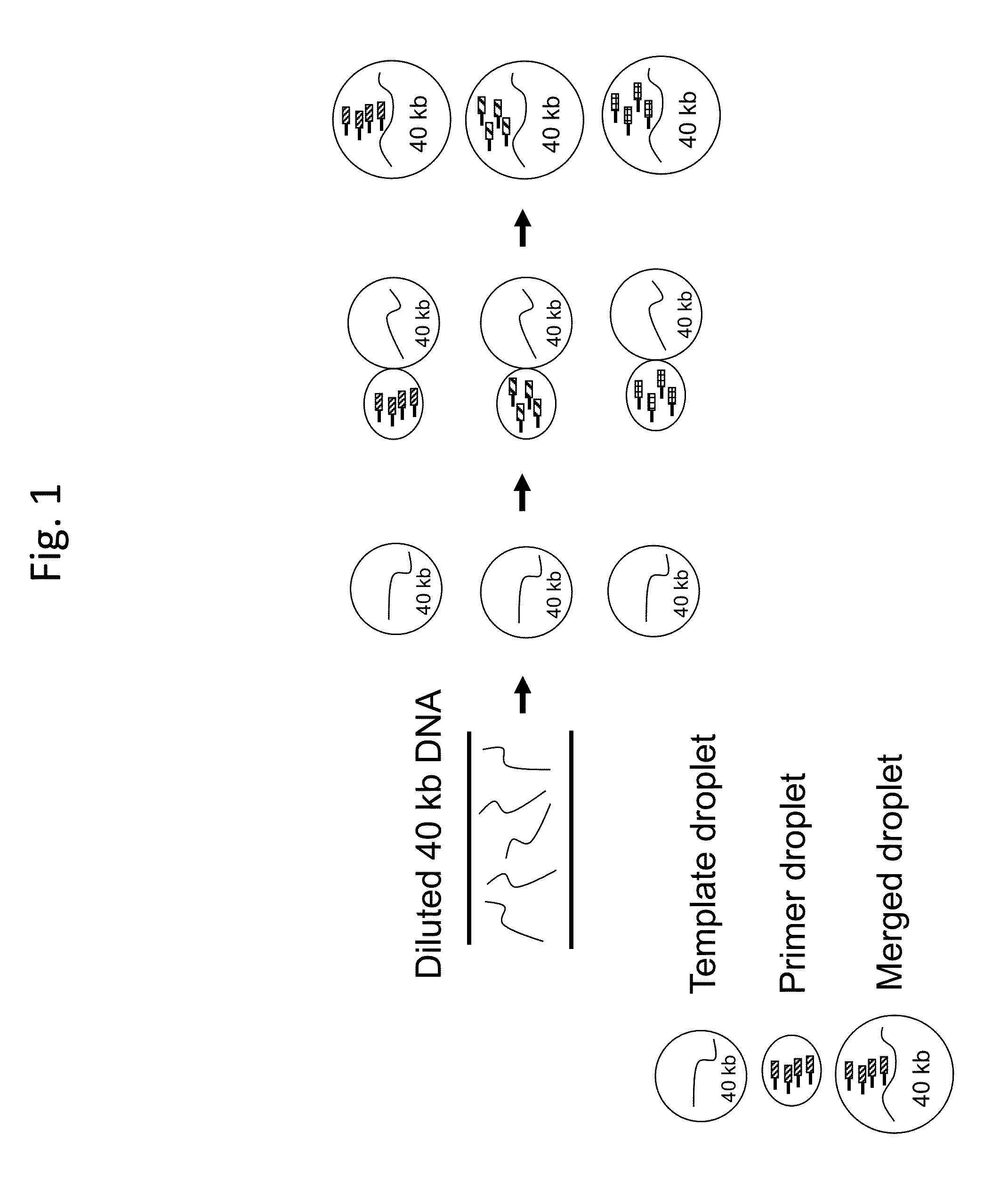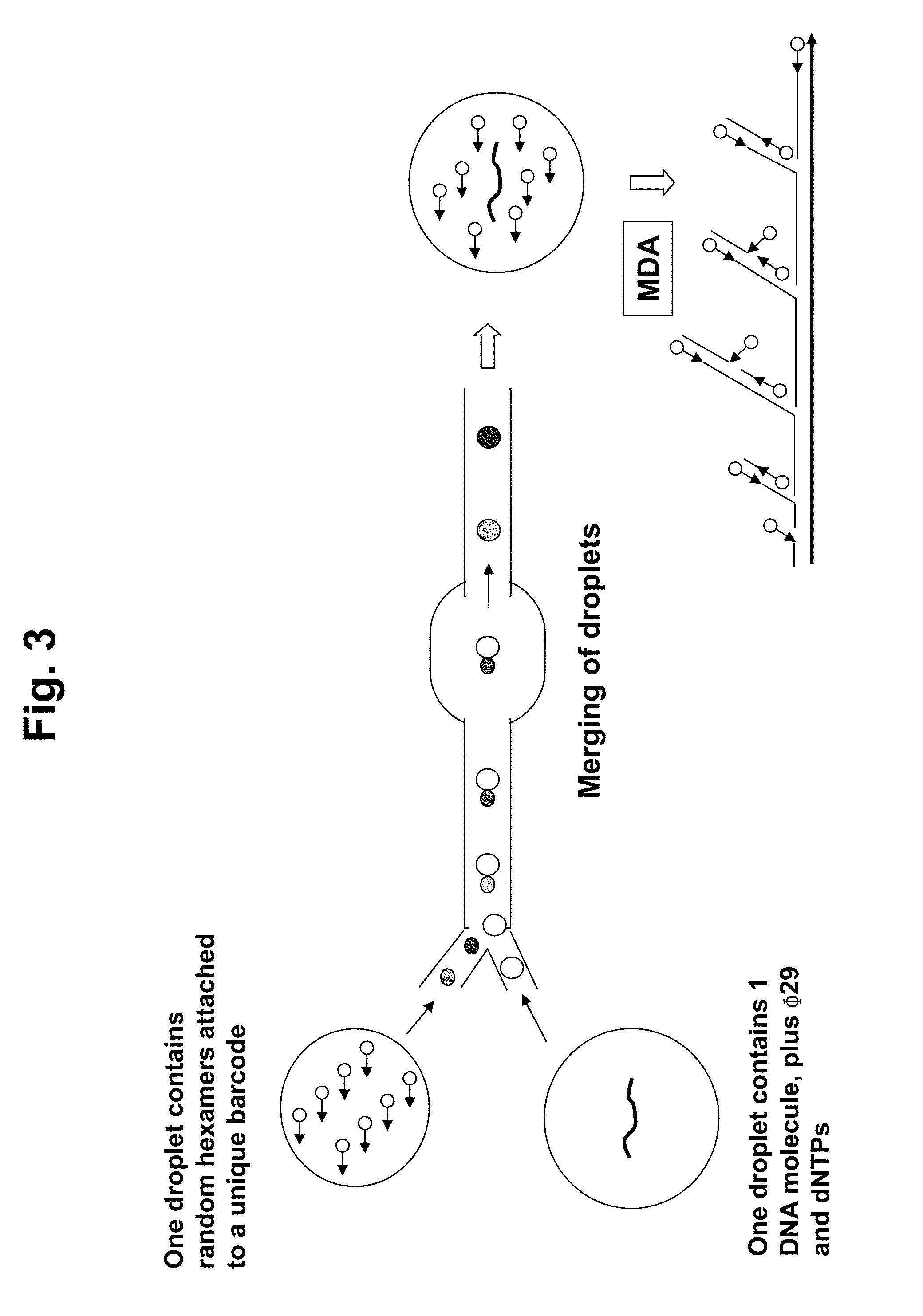Long-Range Barcode Labeling-Sequencing
a barcode and long-range technology, applied in combinational chemistry, biochemistry apparatus and processes, library member identification, etc., can solve the problems of inability to resolve inability to resolve haplotype genetic information, and inability to solve repeats of short reads. to achieve the effect of improving the efficiency of mda
- Summary
- Abstract
- Description
- Claims
- Application Information
AI Technical Summary
Benefits of technology
Problems solved by technology
Method used
Image
Examples
example 1
Clonal Amplification of Large DNA Molecules by MDA Using Bar-Coded Primers for Sequencing and Assembly of Complex Genome and Metagenome
[0069]Large genomic DNA fragments are randomly sheared. High molecular weight DNA fragments are fractionated by electrophoresis in the pulse-field agarose gel. 40 kb DNA fragments are purified and denatured by heating to generate single stranded DNA (ss-DNA) templates. A MDA reaction mixture is prepared, which contains ss-DNA templates, MDA reaction buffer, Phi-29 DNA polymerase and dNTPs, except for bar-coded primers. The reaction mixture is formatted into picoliter-volume water-in-oil droplets by using the RainDance Technologies RDT 1000, a droplet formation device. The DNA templates are diluted to ensure that every droplet contains a single DNA molecule (FIG. 1). About 1 million droplets will be formed, each will contain a single DNA template.
[0070]Bar-coded primers are delivered by fusion of primer droplets with DNA template droplets (FIG. 1). Ea...
example 2
Using Clonal Amplification by MDA Using Bar-Coded Primers in Droplets
[0075]Using the methods described in Examples 1 and 3, we have demonstrated that >10-kb DNA can be inserted into emulsion droplets and amplified to generate enough barcode labeled DNA material for mulitplex sequencing. Until now, it had not been possible to use a single 10 kb polynucleotide molecule as a sequencing template. We used this method to sequence thousands of large, single polynucleotide molecules (>10 kb) in parallel using short read sequencers. A schematic is shown in FIGS. 6 and 7.
example 3
LBL-Seq
[0076]The present methods have been termed Long-Range Bar-code Labeling Sequencing (LBL-Seq). A schematic of the pipeline process is shown in FIG. 8. A sample protocol for LBL-Seq using the RainDance RDT 1000 (RainDance Technologies, Inc., Lexington, Mass.) for droplet formation and merging is shown below.[0077]1. Denature the DNA Molecules. The goal is to denature the large DNA molecules (e.g. 40 Kb fragments) so that they are prepared for merging with barcoded random hexamer primer library.[0078]1.1. Prepare a sample mix in a PCR tube and add DNA sample (˜one million copies of DNA), 10 mM Tris-HCl (pH 7.0) and water.[0079]1.2. Vortex and spin briefly.[0080]1.3. Denature at 95° C. in thermocycler.[0081]1.4. Immediately cool on ice.[0082]2. Prepare master-mix. The goal is to prepare the master-mix which then will be mixed with the denatured DNA molecule prepared in step 1 above. The mixture of denatured DNA molecules and master-mix prepared in this step will be used as DNA Te...
PUM
| Property | Measurement | Unit |
|---|---|---|
| temperatures | aaaaa | aaaaa |
| strand displacement | aaaaa | aaaaa |
| length | aaaaa | aaaaa |
Abstract
Description
Claims
Application Information
 Login to View More
Login to View More - R&D
- Intellectual Property
- Life Sciences
- Materials
- Tech Scout
- Unparalleled Data Quality
- Higher Quality Content
- 60% Fewer Hallucinations
Browse by: Latest US Patents, China's latest patents, Technical Efficacy Thesaurus, Application Domain, Technology Topic, Popular Technical Reports.
© 2025 PatSnap. All rights reserved.Legal|Privacy policy|Modern Slavery Act Transparency Statement|Sitemap|About US| Contact US: help@patsnap.com



